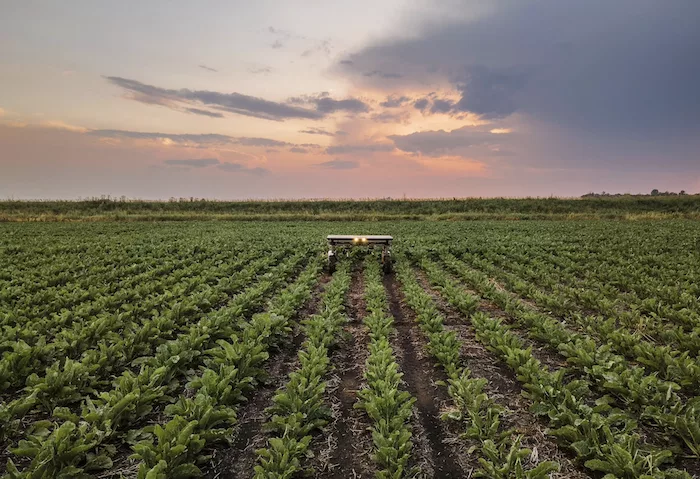Weeds are a huge problem for farmers, who have historically used herbicides to eradicate them. And now, some weeds are evolving into superweeds, or weeds that genetically mutate to be able to survive chemicals that used to kill them off. But what if a robot was able to kill weeds without using herbicides?
That’s where the Model Element, a solar-powered AI robot developed by startup Aigen that weeds crops without chemicals, could play a role. The company is one of the 2024 winners of Amazon Web Services’ (AWS) Compute for Climate Fellowship, and wants to help farmers decrease their dependence on herbicides.
A farming Roomba: Kenny Lee, Aigen’s CEO and co-founder, described the robot as “a Roomba for the farm,” or an autonomous robot that cleans up a farm by cutting the roots of weeds, like a hoe would. The Model Element also has AI cameras that allow it to identify which plants are weeds and understand plant anatomy, so it can hit weeds where it hurts.
With the Model Element, Aigen is trying to solve two problems: first, to overcome superweeds without using a traditional hoe, which relies on physical labor and can be very time-consuming. And second, automating the process without using more energy—hence the solar-powered machines.
“This is a perfect accumulation of all of these things coming together and delivering on a need with climate and agriculture,” Lee told Tech Brew.
How it works: Yuri Brigànce, Aigen’s director of AI and software, told us that the Model Element is split into two parts: the robot, which navigates itself through the field and collects data on crops using AI, and then modules that can perform different tasks. The first module that Aigen created is one that weeds.
“We’re able to build an extremely detailed map and also give you a pretty accurate crop stamp count, weed pressure metrics, and things of that nature,” Brigànce said. “The [AI] model produces predictions and then that goes through a different model, which then does [weed] target selection and controls signals out to the motors.”
And even though the Model Element is solar-powered, it’s able to work continuously thanks to batteries on the bottom of the robot, which also keep the machine’s center of gravity low.
Help from Amazon: Through the fellowship, Aigen will receive up to $1.5 million in AWS computing credits, technical assistance, and professional advice and networking opportunities. Brigànce said the compute credits will allow Aigen to automate the process of labeling the plants picked up by the Model Element’s cameras, among other things.
Helping startups process and make sense of large swaths of data is a big part of the Compute for Climate Fellowship’s mission, AWS’s North America head of startup business development, Kathryn Van Nuys, told Tech Brew.
“The infrastructure that AWS has built—which includes massive amounts of computing power, security, the data center structures that we have set up—startups don’t have to build that themselves,” Van Nuys said. “They can just tap into what AWS has built, and then scale up and down as their needs depend.”
Testing, testing: There are currently 50 Model Elements being tested at farms in North Dakota and Minnesota. Next year, Aigen plans to deploy the “next generation” of robots to California farms—and in 2026, the company hopes the technology will be widely available.
This year, Model Element tests took place at Grand Farm, a North Dakota farming innovation initiative that connects farmers with the latest agriculture technology.
Andrew Jason, head of special projects at Grand Farm, told Tech Brew that farmers save money that would have been spent on herbicides and are able to charge a premium for their product, because now that it’s grown without herbicides, farmers can seek organic certifications for their crops.
“They’re excited about the possibility of the technology,” Jason said of farmers he’s spoken to about Aigen.
That said, Jason told Tech Brew there’s one challenge the Model Element has yet to overcome: scale. Aigen’s robots can weed between 20 and 40 acres during a growing season—but farms tend to be much larger than that. In 2022, the average size of a US farm was 463 acres.
“But where the world’s gonna go, where the technology is gonna go, Aigen is on the right path,” Jason said.




![[Technology Corner] A Big Step Forward for Interoperability & Data Sharing](https://www.precisionfarmingdealer.com/ext/resources/2025/12/12/A-Big-Step-Forward-for-Interoperability--Data-Sharing.webp?height=290&t=1765565632&width=400)


